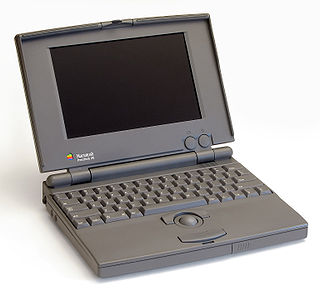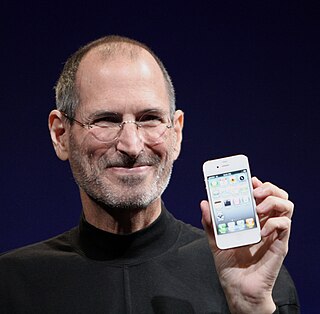Related Research Articles

Fax, sometimes called telecopying or telefax, is the telephonic transmission of scanned printed material, normally to a telephone number connected to a printer or other output device. The original document is scanned with a fax machine, which processes the contents as a single fixed graphic image, converting it into a bitmap, and then transmitting it through the telephone system in the form of audio-frequency tones. The receiving fax machine interprets the tones and reconstructs the image, printing a paper copy. Early systems used direct conversions of image darkness to audio tone in a continuous or analog manner. Since the 1980s, most machines transmit an audio-encoded digital representation of the page, using data compression to transmit areas that are all-white or all-black, more quickly.
HyperCard is a software application and development kit for Apple Macintosh and Apple IIGS computers. It is among the first successful hypermedia systems predating the World Wide Web.

A smartphone, often simply called a phone, is a mobile device that combines the functionality of a traditional mobile phone with advanced computing capabilities. It typically has a touchscreen interface, allowing users to access a wide range of applications and services, such as web browsing, email, and social media, as well as multimedia playback and streaming. Smartphones have built-in cameras, GPS navigation, and support for various communication methods, including voice calls, text messaging, and internet-based messaging apps.

An answering machine, answerphone, or message machine, also known as telephone messaging machine in the UK and some Commonwealth countries, ansaphone or ansafone, or telephone answering device (TAD), is used for answering telephone calls and recording callers' messages.

The history of mobile phones covers mobile communication devices that connect wirelessly to the public switched telephone network.

A clamshell design is a kind of form factor for electronic devices in the shape of a clam shell. Mobile phones, handheld game consoles, and especially laptops, are often designed like clamshells. Clamshell devices are usually made of two sections connected by a hinge, each section containing either a flat panel display or an alphanumeric keyboard/keypad, which can fold into contact together like a bivalve shell.
General Magic was an American software and electronics company co-founded by Bill Atkinson, Andy Hertzfeld, and Marc Porat. Based in Mountain View, California, the company developed precursors to "USB, software modems, small touchscreens, touchscreen controller ICs, ASICs, multimedia email, networked games, streaming TV, and early e-commerce notions." General Magic's main product was Magic Cap, the operating system used in 1994 by the Motorola Envoy and Sony's Magic Link PDA. It also introduced the programming language Telescript. After announcing it would cease operations in 2002, it was liquidated in 2004 with Paul Allen purchasing most of its patents.

The IBM Simon Personal Communicator is a handheld, touchscreen PDA designed by International Business Machines (IBM), and manufactured by Mitsubishi Electric. Although the term "smartphone" was not coined until 1995, because of Simon's features and capabilities, it has been retrospectively referred to as the first true smartphone.

A tablet computer, commonly shortened to tablet, is a mobile device, typically with a mobile operating system and touchscreen display processing circuitry, and a rechargeable battery in a single, thin and flat package. Tablets, being computers, have similar capabilities, but lack some input/output (I/O) abilities that others have. Modern tablets largely resemble modern smartphones, the only differences being that tablets are relatively larger than smartphones, with screens 7 inches (18 cm) or larger, measured diagonally, and may not support access to a cellular network. Unlike laptops, tablets usually run mobile operating systems, alongside smartphones.
Internet fax, e-fax, or online fax is the use of the internet and internet protocols to send a fax (facsimile), rather than using a standard telephone connection and a fax machine. A distinguishing feature of Internet fax, compared to other Internet communications such as email, is the ability to exchange fax messages with traditional telephone-based fax machines.

The PowerBook 100 is a notebook-sized laptop computer designed and manufactured by Sony for Apple Computer and introduced on October 21, 1991, at the COMDEX computer expo in Las Vegas, Nevada. Priced at US$2,500 with external floppy drive, the PowerBook 100 was the low-end model of the first three simultaneously released PowerBooks. Its CPU and overall speed closely resembled those of its predecessor, the Macintosh Portable. It had a Motorola 68000 processor at 16 MHz, 2-8 megabytes (MB) of RAM, a 9-inch (23 cm) monochrome backlit liquid-crystal display (LCD) with 640 × 400 pixel resolution, and the System 7.0.1 operating system. It did not have a built-in floppy disk drive and was noted for its unique compact design that placed a trackball pointing device in front of the keyboard for ease of use.
The Paladin was a conceptual combination of a computer, fax machine, scanner, and telephone all-in-one designed by Apple Computer as a single office solution for a small business, as well as for use in hotel rooms for business travelers. It also went under the code name "Project X" during 1995.
Apple Inc. has had many notable advertisements since the 1980s. The "1984" Super Bowl commercial introduced the original Macintosh mimicking imagery from George Orwell's 1984. The 1990s Think Different campaign linked Apple to famous social figures such as John Lennon and Mahatma Gandhi, while also introducing "Think Different" as a new slogan for the company. Other popular advertising campaigns include the 2000s "iPod People", the 2002 Switch campaign, and most recently the Get a Mac campaign which ran from 2006 to 2009.

In computing, multi-touch is technology that enables a surface to recognize the presence of more than one point of contact with the surface at the same time. The origins of multitouch began at CERN, MIT, University of Toronto, Carnegie Mellon University and Bell Labs in the 1970s. CERN started using multi-touch screens as early as 1976 for the controls of the Super Proton Synchrotron. Capacitive multi-touch displays were popularized by Apple's iPhone in 2007. Multi-touch may be used to implement additional functionality, such as pinch to zoom or to activate certain subroutines attached to predefined gestures using gesture recognition.

The history of the iPhone by Apple Inc. spans from the early 2000s to about 2010. The first iPhone was unveiled at Macworld 2007 and released later that year. By the end of 2009, iPhone models had been released in all major markets.

The Newton is a specified standard and series of personal digital assistants (PDAs) developed and marketed by Apple Computer, Inc. from 1993 to 1998. An early device in the PDA category — the term itself originating with the Newton — it was the first to feature handwriting recognition. Newton devices run on a proprietary operating system, Newton OS; unlike the company's Macintosh computers, Apple licensed the software to third-parties, who released Newton devices alongside Apple's own MessagePad line.

Samsung GT-i8910 Omnia HD is a smartphone manufactured by Samsung Electronics, first announced at MWC 2009 on February 18, 2009. The device was the first phone capable of playing and recording 720p HD video. It runs on the S60 5th Edition (Symbian^1) platform, the only Samsung device to do so.

The iPhone 3GS, stylized as iPhone 3G🅂, is a smartphone that was developed and marketed by Apple Inc. It is the third generation of the iPhone and the successor to the iPhone 3G. It was unveiled on June 8, 2009 at the WWDC 2009, which took place at the Moscone Center in San Francisco.

The iPhone is the first iPhone model and the first smartphone developed and marketed by Apple Inc. After years of rumors and speculation, it was officially announced on January 9, 2007, and was released in the United States on June 29, 2007.

The iPhone 6 and iPhone 6 Plus are smartphones that were developed and marketed by Apple Inc. They are the eighth generation of the iPhone, succeeding the iPhone 5, iPhone 5c and iPhone 5s, and were announced on September 9, 2014, and released on September 19, 2014. The iPhone 6 and iPhone 6 Plus jointly were themselves replaced as the flagship devices of the iPhone series by the iPhone 6s and iPhone 6s Plus on September 9, 2015. The iPhone 6 and 6 Plus include larger 4.7-inch and 5.5-inch displays, a faster processor, upgraded cameras, improved LTE and Wi-Fi connectivity and support for a near-field communications-based mobile payments offering.
References
- 1 2 3 4 5 "Apple WALT prototype shows up on eBay". The Verge . 10 March 2012. Archived from the original on 11 April 2019. Retrieved 11 April 2019.
- 1 2 3 4
- Dickson, Sonny (8 April 2019). "Video of Apple's W.A.L.T. in Action - The 1993-Edition iPhone". SonnyDickson. Archived from the original on 11 April 2019. Retrieved 11 April 2019.
- SonnyDickson (9 April 2019). "Apple WALT". youtube. Retrieved 25 June 2023.
- 1 2 Clover, Juli (9 April 2019). "Apple's 1993 W.A.L.T. Combined Telephone and Fax Machine Prototype Seen in Action in New Video". www.macrumors.com. Archived from the original on 10 April 2019. Retrieved 11 April 2019.